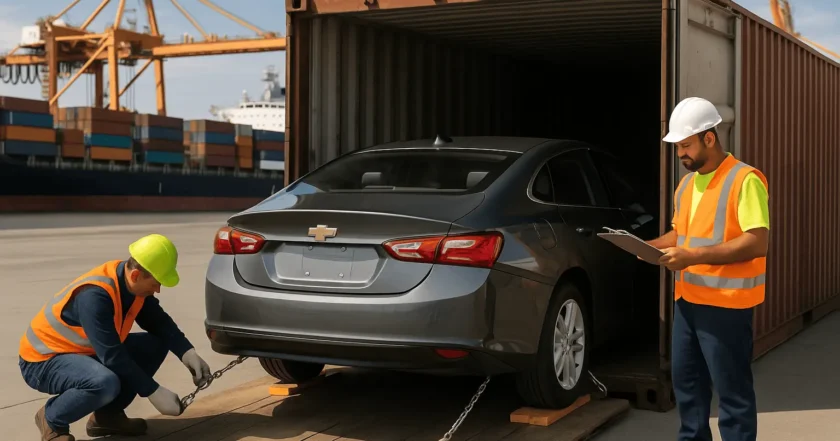Shipping your car overseas is all about preparation. Costs range from about $1,000 for sea transport to tens of thousands for air freight, and factors like distance to port, container type, and destination taxes can double the total. Regulations differ across regions, with the U.S., Europe, and Asia each enforcing strict import and emissions standards. Preparing documents such as the Bill of Lading, ownership proof, and import permits early helps avoid delays, while adding marine insurance protects your vehicle during transit.
By comparing transport methods, checking import laws, and organizing your paperwork early, you can avoid common pitfalls and make sure your vehicle arrives safely, ready for the road ahead.
Key Takeaways
- Overseas car shipping costs vary widely, typically between $1,000 and $5,000 by sea, while air transport can cost tens of thousands. The vehicle type, distance from port, and delivery method all play major roles in determining price.
- Container shipping offers strong protection and flexibility, allowing personal items inside, while RoRo is cheaper and faster for standard vehicles. Air freight is the premium option for rare or high-value cars needing quick delivery.
- Understanding import rules and vehicle standards in the destination country is essential. Regulations differ greatly between regions such as the EU, Asia, and the U.S., and failing to meet them can lead to delays, fines, or rejection.
How Much Does Overseas Car Shipping Cost?
There are a lot of factors to consider when shipping a car overseas, which will influence the final shipping price, whether by air or sea is a big one. On average, sea shippers charge around $1,000 to $5,000 to get their cargo across the ocean. Smaller cars start at $750, and shipping an SUV (Sport Utility Vehicle) by air can run as high as $40,000.
The type and size of the vehicle are important: larger or heavier vehicles will be more costly. Your distance from the nearest port will also impact expenses. If you live close to a major port like Miami, New York, or San Francisco, it may cost around $100-300 to get your car there; from inland, this may increase to nearly $1,000 because a transporter would have to deliver your car to the port.
Import taxes in the destination country may take a huge toll and may go beyond shipping costs. How you get the car is also important: it’s cheaper to pick it up at the port. The more advanced the delivery, the pricier it becomes. Some offer expedited shipping that can cut the time from weeks to just a few days with a lot of extras.
Your container type will determine the prices and protection offered. A shared open container is cheaper than an enclosed or private container. Enclosed or private containers cost more but offer better protection for your car, mainly if it is a luxury or classic.
Here are some examples of typical shipping costs to certain destinations:
- Germany ($900 – $3,900)
- Europe ($850 – $5,000)
- United States ($1,000 – $5,000)
- West Africa ($1,500 – $2,500)
- Australia ($3,000 – $5,000)
Types of International Car Transport
It is imperative to choose the right car shipping method to ensure that an automobile arrives safely, on time, and at a cost-effective price. Each method has advantages and disadvantages, and knowing the inner workings of each type will help determine which one is the best fit.

Whether moving a family car, shipping a luxury automobile, or exporting commercial fleets, here are the three most common options.
Container Shipping
Container shipping is one of the safest and most versatile methods, with cars being locked inside a metal container. This all-encompassing envelope helps to shield the car from theft, weather, and accidental damage on the journey. Bonus perks include the possibility of loading personal belongings along with the car, contributing to this method’s popularity during relocation.
| Benefits | Drawbacks |
| Maximum security, ideal for luxury or classic cars, suitable for non-operational vehicles. | Higher expenses relative to other methods, longer waiting time due to possible shared container departure |
Containers account for some 16% of the volume in world maritime shipping whilst representing more than half of the total value carried, indicating their importance for high-value cargo like cars.
RoRo Shipping
One of the cheapest ways of transport is RoRo shipping. Vehicles are driven onto the ship through ramps and secured on multiple decks, similar to a floating parking structure. This helps loading and unloading operations to be very fast compared to cranes or lifts.
| Benefits | Drawbacks |
| Less expensive than container shipping, prompt movements in ports, and best suited for standard raven vehicles | Personal items cannot be included in cars, and RoRo is subject to weather conditions |
Modern-day RoRo vessels, especially Pure Car and Truck Carriers (PCTCs), are huge. By the year 2025, the largest RoRo vessels will be capable of carrying over 9,500 Car Equivalent Units (CEU), demonstrating how economies of scale can lower costs and enhance the efficiency of global vehicle exports.
Ship by Plane
Air transport is the swiftest means by which one can ship a vehicle internationally, and delivery can occur as fast as 3 to 10 days. Cargo planes are utilized primarily for the transport of vehicles and hence are therefore the preferred method to use for high-end cars, racing cars, or when there is an urgent need for delivery.
| Benefits | Disadvantages |
| Quickness, secure handling, and complete safety for rare or high-value cars. | Cost that can run into tens of thousands, therefore making it impractical for most standard vehicles. |
International air freight speaks volumes as far as its importance is concerned. According to the International Air Transport Association (IATA), more than 52 million metric tons of cargo are now being transported every year by airlines, holding more than 35% of world trade by value. This means about 6.8 trillion dollars’ worth of goods might be moving annually – approximately $18.6 billion daily.
This is what settles why air freight, though very expensive, is the choice on top of all other choices for any shipment that is time-sensitive or of great value.
When making your decision, consider budget, vehicle type, schedule, and destination. For strict affordability, RoRo works best; containers generally give a balance between cost and security; air freight is king when it comes to speed. For an in-depth analysis of the logistics pertaining to these methods, this handy guide will walk you through: Auto Transport Process Explained.
Documents and Regulations for International Car Transport
Study the destination rules regarding an overseas car shipment thoroughly and the early preparation of auto transport documents to ensure compliance, avoid delays, and evade an expensive customs problem or rejection.
Regional Regulations
If you’re thinking on shipping your car abroad, it’s important to know the import rules, duties, safety standards, and documentation requirements of the place you want to ship the car to.
European Union (EU)
- The basic Euro 6 and Euro 7 regulations for emissions and safety apply in all member states, with more stringent laws potentially being implemented in different jurisdictions.
- Many national-level regulations on older cars exist that could force owners of such vehicles to pay more import duties, or, in some extreme cases, to prevent their import entirely. Poland has recently insisted on working DPFs, while the Serbian authorities have suggested imposing bans on Euro 3 to Euro 5 vehicles.
- While importing older vehicles, costly inspection procedures may be imposed, on top of inspection fees, and possibly rejected.
Asia
- Based on the countries, the rules vary significantly. Some have stricter age limits for vehicles: for example, only vehicles under 5 years of age may be welcomed.
- The rest of them may restrict the importation of vehicles of non-local make or may impose expensive modifications so that the vehicle will conform to their safety standards.
- Before booking a shipment, always verify the requirements with your destination country’s customs office.
United States (U.S.)
- To be imported, vehicles should meet both the Environmental Protection Agency (EPA) and Department of Transportation (DOT) regulations.
- Such vehicles that are found to be non-compliant may eventually be carried at huge expenses of modifications; or otherwise, they may not be eligible to enter.
- Temporary importations may be offered an exemption, provided it is strictly for professional exhibitions or any short duration stay; but conditions approving exemptions are very stringent.
Required Documentation Checklist
For smooth clearing through customs, the utmost necessary documentation includes:
- Bill of Lading – a BOL mentioning your car’s details and its condition.
- Title & Registration – proof of ownership; any lien must be cleared.
- Import Permit – usually required; always apply ahead.
- Photo ID and Power of Attorney – may be required by your forwarder.
Missing documents will definitely cause fees, delays, or even refusals. Always confirm requirements with your forwarder.
Insurance Considerations
No insurance should be assumed; in fact, most carriers will cover only limited liability. Marine cargo insurance would be more apt for real protection, especially for a really nice or classic car. No car shipping insurance in the U.S.? You’ve got a hassle of a risk.
Also, any U.S. auto insurance will not cover you abroad; one may have to get local coverage or registration if they happen to be relocating.
What Are the Tips for Shipping An Electric Car Overseas?
When transporting an electric car overseas, some extra steps will have to be taken, since lithium-ion batteries are hazardous cargo. A DGD, or Dangerous Goods Declaration, signed by recognized professionals, must be submitted by your logistics agents, such as Tempus Logix.
Some carriers also have other requirements, including age restrictions for EVs, or measures such as having the battery disconnected, partially charged, or being shipped separately. Given that the transit environment affects battery health, working with an international car shipping company will simplify compliance and reduce risks for a safe delivery.
Shipping a car overseas involves more than booking transport. Costs, shipping methods, documents, and regulations all play a role in a smooth process. By preparing the right paperwork, choosing the best method for your budget and vehicle, and understanding destination rules, you can avoid delays and unexpected expenses. With the right planning, your car will arrive safely and on time, ready for the road ahead.
Sources
- International Air Transport Association (IATA). “Cargo and Logistics”, Accessed October 21, 2025.
- Port Economics, Management and Policy “Ports and Container Shipping“, Accessed October 27, 2025.
- United States Department of Transportation (DOT). “EPA”. Accessed October 25, 2025.
- European Union. Regulation (EC) No 715/2007 “Document 32007R0715“. Accessed October 25, 2025.





